Bitcoin Nears $106,000: Will Resistance Crush the Rally?

Bitcoin Closes In on $106,000, But Resistance Could Derail the Hype Train
Bitcoin is charging ahead, hitting around $105,700 and setting its sights on $106,000 as market momentum builds. Yet, as the top cryptocurrency eyes its all-time high of nearly $112,000, a looming resistance at $106,200—flagged by on-chain data—could slam the brakes on this rally.
- Bitcoin’s price hovers at $105,700, up 1.3% in the last 24 hours and over 1% in the past week.
- Resistance at $106,200, tied to short-term holder (STH) realized prices, may spark selling pressure.
- Support could kick in at $97,500 if the surge falters, with the all-time high of $111,871 still in play.
Bitcoin’s Surge: What’s Driving the Climb?
The numbers tell a story of renewed vigor for Bitcoin. According to CoinGecko, the price has ticked up 1.3% in the past day and over 1% across the last seven days, recovering from a recent dip to $101,000. This isn’t just retail FOMO—there’s serious muscle behind it. US spot Bitcoin ETFs saw inflows of $5.24 billion in May alone, per Cointelegraph data, signaling that institutional players are piling in. For the uninitiated, ETFs are exchange-traded funds that track Bitcoin’s price, allowing traditional investors to gain exposure without directly owning crypto. This kind of mainstream adoption is a bullish sign, suggesting Bitcoin is increasingly viewed as a legitimate asset class, not just a speculative toy.
But before we start carving Bitcoin’s name on the financial Mount Rushmore, let’s pump the brakes. Institutional interest can cut both ways—big players often have itchy trigger fingers during volatility, and a mass exit could tank prices faster than a meme coin rug pull. Still, for now, the inflows paint a picture of confidence, and that’s fueling the push toward $106,000 as the resurgence continues.
Technical Hurdles: Why $106,200 Is a Wall
Here’s where things get dicey. On-chain analyst Burak Kesmeci, posting on X, has zeroed in on $106,200 as a critical resistance level. This isn’t a random guess—it’s based on the realized price of short-term holders (STH) in the 1-week to 4-week unspent transaction output (UTXO) age band, as detailed in on-chain UTXO age band data. Let’s break that down for clarity. UTXOs are like digital IOUs, representing chunks of Bitcoin that haven’t been spent yet. The “realized price” is the average cost at which these recent buyers acquired their BTC. When the market price hits this level, many STH tend to sell, either to break even or pocket a quick profit, creating a price ceiling where upward momentum stalls.
Short-term holders are the jittery day traders of the crypto world—trigger-happy and rarely willing to ride out a storm. Unlike the “diamond hands” crew (those long-term holders who cling to their Bitcoin through hell or high water), STH often bolt at the first sign of green. Kesmeci’s data suggests a wave of selling could hit at $106,200, pushing prices down unless buying pressure overwhelms it. On-chain analysis, for those new to the term, is like blockchain detective work—using transparent transaction data to map investor behavior. It’s not a crystal ball, but it’s a hell of a lot more reliable than some influencer’s “to the moon” tweet, and you can explore community insights on platforms like Reddit for on-chain discussions.
Other levels to watch include a secondary resistance at $87,300 for STH in the 1-month to 3-month UTXO band, though it’s less relevant right now given Bitcoin’s upward trajectory. If the price does slip, a support zone at $97,500—tied to STH in the 3-month to 6-month band—might act as a safety net. Think of support as a floor where buyers often step in to defend their positions, halting further declines. Additional cushions could form around $93,000 or $100,000 if selling intensifies, per community charts on platforms analyzing support and resistance levels, but $97,500 is the key line in the sand for now.
Historical Context: Bitcoin’s Boom-and-Bust Cycles
Zooming out, Bitcoin’s price action isn’t happening in a vacuum. Its history is a rollercoaster of sharp climbs and brutal drops, often tied to events like halvings—programmed cuts in mining rewards that happen roughly every four years, reducing Bitcoin’s new supply and historically sparking bull runs. The most recent halving in April 2024 set the stage for current optimism, as past cycles (like 2020-2021) saw prices soar post-halving before corrections kicked in. Today’s push toward $106,200 fits this pattern, but history also warns of volatility. A pullback from near its peak of $111,970 to $104,823 earlier this year shows how quickly sentiment can flip. Is $106,200 just a speed bump, or a sign of another correction brewing? Only time will tell, but Bitcoin’s past suggests we brace for both outcomes, as explained in foundational resources like Bitcoin’s historical overview.
Macroeconomic Wildcards: Fed Moves and Jobs Data
Bitcoin doesn’t operate in isolation—it’s tangled up with global financial currents. Take the upcoming US jobs report on June 6, flagged as a potential game-changer in recent market sentiment analysis. If the data shows a strong labor market, the Federal Reserve might delay interest rate cuts, bolstering the US dollar and putting downward pressure on risk assets like Bitcoin. We could see a retreat to $102,000 or lower as investors flock to safer bets like bonds. On the flip side, weaker-than-expected numbers could reinforce a disinflation narrative, prompting rate cuts that make high-risk, high-reward plays like Bitcoin more attractive. Lower rates often drive capital away from low-yield assets into speculative markets, and BTC could soar on that wave.
This macro dance isn’t just trivia—it’s a reminder that Bitcoin, for all its decentralized swagger, isn’t immune to centralized policy. A strong dollar can bruise BTC, while a dovish Fed could be rocket fuel. Add in upcoming CPI (Consumer Price Index) data, and you’ve got a recipe for volatility that no amount of on-chain analysis can fully predict. Hodlers, keep your seatbelts fastened.
Market Sentiment: Greed, Caution, and Dark Clouds
Investor psychology adds another layer to this puzzle. The Crypto Fear and Greed Index, a snapshot of market mood, currently sits at a “Greed” score of 57 out of 100. It’s not full-blown euphoria, but it hints at optimism—and maybe a dash of overconfidence. For context, this index measures factors like volatility and social media sentiment to gauge whether traders are leaning bullish or bearish. A score above 50 suggests greed is winning, which can precede overheated markets ripe for a correction, and you can dive deeper into what drives Bitcoin price fluctuations through community Q&A platforms.
Technical traders on platforms like TradingView spot a bullish flag pattern on Bitcoin’s 4-hour chart, projecting a breakout above $106,934 could target $111,500. Yet, others see a shorting opportunity between $107,000 and $108,000, expecting rejection followed by a drop to $96,000, especially with macro data releases looming. Bitfinex analysts even toss out a $115,000 target by July if institutional momentum holds. Let’s cut the hopium, though—crypto doesn’t run on blind optimism. These predictions are noise without sustained volume and hard data to back them up. Stick to on-chain metrics and macro trends, like those tracking short-term holder behavior impact on price, and leave the fortune-telling to carnival booths.
Then there are darker risks lurking. Regulatory headwinds, like potential SEC crackdowns on ETFs or harsher crypto taxation, could spook investors. Environmental FUD (fear, uncertainty, doubt) around Bitcoin mining’s energy use still rears its ugly head, even if innovations like renewable-powered mining are gaining traction. These threats don’t negate Bitcoin’s potential, but they’re a reality check. No matter the storm, though, Bitcoin’s core strength—its unstoppable, borderless network—remains a defiant middle finger to centralized overreach.
The Big Picture: Decentralized Conviction vs. Speculative Noise
Stepping back, Bitcoin’s flirtation with $106,200 isn’t just a numbers game—it’s a battleground between speculative greed and long-term conviction. Breaking this resistance could pave the way to $111,871, a psychological win for hodlers and a signal that decentralized money is gaining ground. Every tick upward accelerates a future where centralized finance gets dethroned by code and consensus, aligning with the ethos of effective accelerationism—pushing disruptive tech forward, damn the naysayers.
But let’s play devil’s advocate. Does breaching $106,200 even matter in the grand scheme? Bitcoin’s real test isn’t a price point—it’s whether it can shrug off macro headwinds and prove its store-of-value thesis when fiat systems buckle. And while Bitcoin reigns as the king, altcoins like Ethereum carve out niches in DeFi and smart contracts—spaces Bitcoin isn’t built to dominate. That’s not a flaw; it’s a feature of a decentralized ecosystem where specialization fuels innovation. Bitcoin doesn’t need to be everything to everyone, and that’s its quiet genius.
The road ahead is a gauntlet. On-chain data, institutional inflows, and halving cycles scream bullish, but speculative volatility, regulatory noise, and macro wildcards loom large. Bitcoin’s fate at $106,200 isn’t just a trader’s gamble—it’s a litmus test for whether decentralized grit can outmuscle short-term chaos. Keep your skepticism razor-sharp and your eyes on the blockchain, because in this space, complacency gets you rekt.
Key Questions and Takeaways on Bitcoin’s Next Move
- What’s powering Bitcoin’s rise to $105,700?
A recovery from $101,000, boosted by $5.24 billion in US Bitcoin ETF inflows in May, reflects strong institutional confidence, though exact catalysts remain fluid. - Why does the $106,200 resistance level matter for Bitcoin?
It’s the realized price for short-term holders in the 1-week to 4-week UTXO band, likely triggering sales for profit-taking, which could stall the upward push. - How do short-term holders affect Bitcoin’s price swings?
Their speculative, quick-to-sell nature creates volatility, forming resistance or support at key cost basis levels like $106,200 or $97,500 based on recent buying prices. - What happens if Bitcoin can’t surpass $106,200?
A retreat is possible, with support potentially at $97,500 or lower at $93,000–$100,000, where buyers might step in to halt further declines. - Is Bitcoin’s all-time high of $111,871 within reach soon?
Clearing $106,200 opens the door, but macro factors like US jobs data and sustained buying pressure will ultimately dictate the timeline. - Could macroeconomic trends derail Bitcoin’s momentum?
Yes—a strong US jobs report could delay Fed rate cuts, strengthening the dollar and pressuring Bitcoin downward, while weak data might fuel bullish tailwinds. - Are there broader risks to Bitcoin’s rally beyond price levels?
Regulatory moves, like SEC actions on ETFs, and environmental criticism of mining could sour sentiment, though Bitcoin’s decentralized core remains resilient.



